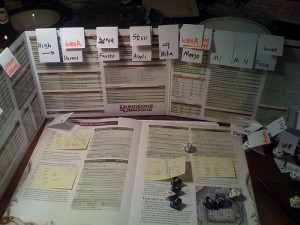
The DM’s screen – the great barrier that separates the DM from the players. Behind the screen the DM can do whatever he pleases. Personally I detest the DM’s screen. It forms a literal barrier that divides the table and cuts the DM off from the rest of the group. I feel that the screen only serves to perpetuate the incorrect belief that it’s the DM vs. the players. The screen denotes exclusivity and secrecy and in my vast gaming experiences it often gives the DM a false sense of self-worth, self-importance and power over the rest of the table.
Obviously the DM’s role in the game is different from that of the players. Yes, the DM has more to do, and controls all of the monsters, and decides on how things in the world play out, so I understand why some DMs get drunk with power. But there’s a simple way to level the playing field and bridge any ill will between the DM and players, and that’s to stop using the screen all together. I realize this may be scary for some DMs, so we’ll look at the most common reasons for using a screen and review the pros and cons of each.
Secrecy
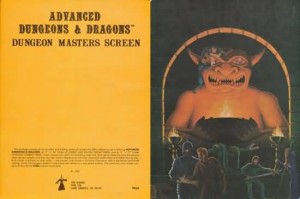 Despite my dislike for the DM’s screen, it can be a useful tool and does have a place at the gaming table if you want it to. The most obvious reason to use the screen is secrecy. If you need to have something in front of you as the DM, but you don’t want the players to see what that something is, use the screen. Typically this would include monsters the PCs haven’t yet encounters, or maps with traps and secret doors clearly marked.
Despite my dislike for the DM’s screen, it can be a useful tool and does have a place at the gaming table if you want it to. The most obvious reason to use the screen is secrecy. If you need to have something in front of you as the DM, but you don’t want the players to see what that something is, use the screen. Typically this would include monsters the PCs haven’t yet encounters, or maps with traps and secret doors clearly marked.
If you’re a DM who chooses not to use a screen you need to be mindful of wandering eyes. If you keep a copy of the master map in plain view of the players sitting next to you, then expect them to look for the secret doors in the correct places. If you have the Monster Manual open to the page you need, expect the players who can see the Rust Monster’s picture to caution the PCs wearing metal to stay back. The simplest way to avoid these problem is to keep things covered or out of sight until needed. Alternatively, one way I’ve messed with players who steal glances at my notes is to plant a few red herrings on the map or leave the books open to monsters they will never fight. They learn quickly not to trust what they see and eventually stop looking.
Another reason for secrecy, especially for less experienced DMs is to keep the Gaming Jerks from telling you what to do or what you’re doing wrong. For example, when I use minions I like to roll for their damage rather than use a set number. Players know monsters that always do the same damage are likely minions and treat them as such. By rolling damage I keep the players on their toes for a few rounds. However, I once ran an FLR adventure where a player who could see the stat block for the minions literally reached over, pointed at the monsters’ set damage, announced to the table that the monsters were minions, explained to me that they should only be doing 6 damage each, and then told me that I wasn’t running them correctly. I politely told the player that my changes were intentional and I continued doing what I was doing despite his gross violation of the D&D social contract. Had I been a less experienced or less confident DM this could really have shaken me up. This is a problem that would have been totally avoidable had I been using a screen.
Separating player knowledge from character knowledge
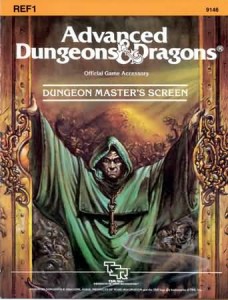 This is the only reason that I advocate using a screen. Sometimes players have a difficult time accepting that their characters are unaware of something that they as players know with absolute certainty. For example, a player decides that his Rogue is going to search the chest for traps before opening it. Let’s say he rolls a 2 and the DM tells him there are no traps. Immediately the other characters say they want to check it as well. Had the Rogue rolled a natural 20 and been told there were no traps no one else would have bothered checking. After all this is the Rogue’s area of expertise, if he says there are no traps there must not be any traps. But because the players saw the roll they behave differently. I’ve also seen this happen in social situations when poor Diplomacy checks are made or in dungeons when the party is searching to find secret doors. If the DM made these rolls secretly on behalf of the PC the players would have to decide if they accept a failure as a poor roll or a result of circumstances. If the party agrees to let the DM do secret check for them then I wholehearted endorse the use of a screen for this purpose.
This is the only reason that I advocate using a screen. Sometimes players have a difficult time accepting that their characters are unaware of something that they as players know with absolute certainty. For example, a player decides that his Rogue is going to search the chest for traps before opening it. Let’s say he rolls a 2 and the DM tells him there are no traps. Immediately the other characters say they want to check it as well. Had the Rogue rolled a natural 20 and been told there were no traps no one else would have bothered checking. After all this is the Rogue’s area of expertise, if he says there are no traps there must not be any traps. But because the players saw the roll they behave differently. I’ve also seen this happen in social situations when poor Diplomacy checks are made or in dungeons when the party is searching to find secret doors. If the DM made these rolls secretly on behalf of the PC the players would have to decide if they accept a failure as a poor roll or a result of circumstances. If the party agrees to let the DM do secret check for them then I wholehearted endorse the use of a screen for this purpose.
Quick reference
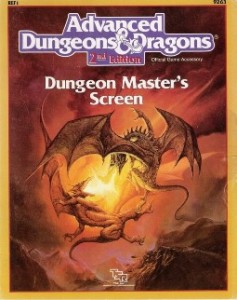 Most iterations of the DM’s screen are more than just a gatefold piece of cardboard; on the side facing the DM there are usually quick reference charts. The information included on the screen tends to be things that come into play frequently, but not frequently enough that you’re likely to have it memorized. Usually it’s charts or details that scale with level. These are certainly helpful, especially for rookie DMs, but all of these details are available in other sources.
Most iterations of the DM’s screen are more than just a gatefold piece of cardboard; on the side facing the DM there are usually quick reference charts. The information included on the screen tends to be things that come into play frequently, but not frequently enough that you’re likely to have it memorized. Usually it’s charts or details that scale with level. These are certainly helpful, especially for rookie DMs, but all of these details are available in other sources.
If this is the only reason you’re using a screen, I’d suggest marking the pages of your Rules Compendium or DMG with tabs so you can find them quickly when you need them thereby eliminating the need for a screen. In my experience, the players are often just as good a resource as the charts on the screen. If I’m not sure of something I can ask the player and usually someone knows the correct ruling. Alternatively as the DM I can and often do, just go with my gut and make a call on the fly.
Rolling

 I’m a big believer that all dice rolling should be done in plain sight in front of everyone. After all, for me at least, rolling the dice is one of the most exciting parts of the game. Whether I’m rolling to hit or it’s the DM rolling to hit me, the thrill of seeing that d20 roll and eventually stop on a number that will spell success or failure thrills me. When I’m a player and I roll a natural 20 I cheer. I also cheer whenever someone else rolls a natural 20. It’s usually a big deal when it happens so I like to treat it as such. As the DM my reaction is the exact opposite. My goal isn’t to kill the PCs, so when I roll a 20 I usually cringe and make a face of disgust because I know a PC is about to get raked over the coals.
I’m a big believer that all dice rolling should be done in plain sight in front of everyone. After all, for me at least, rolling the dice is one of the most exciting parts of the game. Whether I’m rolling to hit or it’s the DM rolling to hit me, the thrill of seeing that d20 roll and eventually stop on a number that will spell success or failure thrills me. When I’m a player and I roll a natural 20 I cheer. I also cheer whenever someone else rolls a natural 20. It’s usually a big deal when it happens so I like to treat it as such. As the DM my reaction is the exact opposite. My goal isn’t to kill the PCs, so when I roll a 20 I usually cringe and make a face of disgust because I know a PC is about to get raked over the coals.
Rolling behind the screen breeds distrust. Players will often wonder if you’re being honest about the results. This is especially true when the dice get really hot or really cold. Most players don’t want to be coddled; they want the dice to determine the course of the events good or bad. If the DM is fudging numbers the players feel cheated. By rolling in plain sight there’s never any doubt. I’ve seen many DMs use the screen but do all rolling in front of the party. This is a reasonable compromise that I’m ok with.
When it comes to rolling damage I’m less invested. If it’s a hit I don’t care if the damage dice are rolled in front of me or not. As a DM I will often pre-roll damage to make things run faster, and I often encourage players to do the same. In my mind the hit that matters more than the damage.
If you’re a DM who does roll behind the screen then take advantage of it. If the party is getting absolutely destroyed, consider fudging the numbers a bit. I now I already said I like the dice to fall where they may, but a good DM knows that from time to time the party will need some help. I’m not saying all the time, but there will be rare occasions when you know that if things keep going the way they’re going it will be a TPK. In these cases switch to a smaller damage die, or cut the number you roll in half. If you’re rolling in the open this is a lot harder to do and not be noticed, but if you’re behind the screen you can throw the PCs a bone every now and then.
To screen or not to screen?
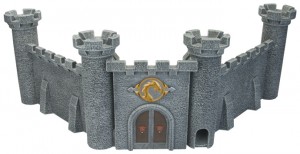 In my opinion DMs should not use the screen. Although there are a few good reasons why you may want to use it, in my mind the reasons for not using it far outweigh the reasons for using it. Anything that separates the DM from the players is bad for the game. The gaming experience should be one of inclusion and shared story-telling. By using the screen you immediately create physical division and a feeling of taking sides. By foregoing the screen and embracing the group dynamic, you’ll likely find that you have a more positive gaming experience and that it’s less likely to create and atmosphere of players vs. DM.
In my opinion DMs should not use the screen. Although there are a few good reasons why you may want to use it, in my mind the reasons for not using it far outweigh the reasons for using it. Anything that separates the DM from the players is bad for the game. The gaming experience should be one of inclusion and shared story-telling. By using the screen you immediately create physical division and a feeling of taking sides. By foregoing the screen and embracing the group dynamic, you’ll likely find that you have a more positive gaming experience and that it’s less likely to create and atmosphere of players vs. DM.
Do you use the screen? What other pros and cons can you add to this discussion? What do you feel are the best and worst reasons for using a screen? What game do you think has the best screen?
 Looking for instant updates? Subscribe to the Dungeon’s Master feed!
Looking for instant updates? Subscribe to the Dungeon’s Master feed!
19 replies on “Should the DM Use a Screen?”
I use a DM screen for the “quick reference” function you described, but I usually have it folded or sitting off to the side until I need it. I don’t set it up as a wall between me and the players, but I sometimes do set one up to shield minis or other surprises from the players—again, off to the side, not between me and the players. I have both of the D&D 4e screens shown in the post, so I keep one near me and hand the other one to the players on the other side of the table, so that everybody has quick reference to the charts. When I play (as a PC) at cons, I take a DM screen with me for quick reference. To me, that’s the real value of the screen.
Very nice post. I can definitely see both sides of this argument but I am a big proponent of DM screens. I like the convenience they provide in terms of quick reference materials, and I like the air of mystery they lend. I like my notes and NPC/monster minis back there, so there’s that moment of “uh-oh” when something comes out from behind the screen to land on the map. I’m a big “let the dice fall where they may” DM and my players know this. But when a momentous die roll is about to occur I roll that in the open. I feel that helps build tension as the die is bouncing about the table and everyone is holding their breath waiting to see where it lands.
As for my favorite screen that is easy: the HackMaster 4th edition GameMaster’s Shield. That’s right. Not “screen” but “shield”. That thing is a beast. 24 panels (I think) of charts and rules with places for customization with dry-erase markers. Love that thing. Always made my players cringe when it got flipped into “battle-mode” too.
I have just recently stopped using the DM screen (after 30 years) as a shield between the players and me; I now keep it off to the side for reference. I started in part because I heard Chris Perkins rarely uses it and the 3.5 screen was so high I couldn’t see the battlemat over it. Now DMing 4e, I trust the math more than 3.5 so I don’t have to fudge the die rolls (usually in my favor since the players could clobber anything I put in front of them in 3.5). I’ve never had a problem of players looking at my die rolls or my information; I’ve always trusted them so they end up trusting me.
Another great article.
I have used screens in games of 2e and 4e, but since the last season of D&D Encounters I have started running screenless as it enables me to see the table and battlemat easier. I always roll in front of the players anyway and let the die fall where they may.
I still have my screen with me in my “bag of tricks” but just as a fall back to check on.
Out of my screens I prefer the layout of the 4e one that I got in the DM’s box set.
I tried using a classic DM screen with all the charts on it but found that it was too tall and that the bit of the screen I need to read was always in shadow. Now I just have a low “barricade” of a dicebag. It hides rolls enough and I can cover maps with other sheets of paper when I need to.
I agree with your post, although I suspect the screen is also a bit of a confidence boost for inexperienced DMs. It is after all a symbol of the DM’s role at the table 😉 I do tend have the screen laying flat next to my adventure notes for quick reference reasons you mention.
My players told me that better i’ve to use the screen after a night rolling crits while playing a dragon 😀
I haven’t used a screen for years, and I feel like I’m better for it, though now I usually have a laptop at the table that often serves the same purpose. I like the quick reference aspect, but I’m with Derek. I do all my dice rolling in plain view, so they fall where they may. It removes the temptation for me to fudge, because I know that no one at my table prefers it.
I love using a DM screen. It keeps the secret things secret (like a creatures HP or AC or weaknesses). Rolling dice in front of the players is something that I’ll consider, but his article just confirms everything that is good about using a screen.
As a player I like looking at the evocative art on a good screen (the Hollow Earth Expedition screen immediately springs to mind)…it can be evocative and add to the mood.
[…] Should GM’s use a screen? Derek over at Dungeon’s Master explores the topic this week. I’m not a screen user myself, but Ryan is. There are pros and cons to each style, and this post discusses them in depth. Read the full article on Dungeon’s Master. […]
Don’t forget the adventures that come with the DM screen. “Terrible Trouble at Tragidore” (which came with the 2nd ed screen) brought us so much frustration. But I’ve nonetheless included a town called Tragidore in every game I’ve run since. Just because.
I usually run without a screen, unless I have a specific reason to want surprise. I try to get the actual miniatures of any monsters I use, so I can lift the screen to reveal the monster when it finally arrives. I did this with the last season of Encounters, when the strange green elf started to get more lizardlike and I replaced him with a draconian mini… then he fully polymorphed into a dragon, and I pulled the dragon mini out from behind the screen.
Though I will admit that the epic awfulness of rolling 4 crits against my Encounters table was impossible to adjust when I rolled on the open table. Oh well, the players knew I wasn’t outright just trying to slaughter them, and the fickleness of the dice made the players realize just how much risk was involved in fighting monsters.
I use a DM screen for the following reasons:
1) I keep track of monster stats behind the screen, and I don’t want the players that sit next to me to be able to see damage totals, etc.
2) I keep monsters for the next encounter behind the screen, so I don’t have to waste time pulling multiple figs out of multiple boxes.
3) Most of my rolls are public, but I usually roll stealth checks behind the screen when there are creatures the players are unaware of, or to see if monsters in the area hear the players making noise… or sometimes I just roll randomly to freak the players out. Gotta keep ’em guessin’.
I would love to use a DM screen, if only I had one. And despite all that dislike Ameron has for the DM screen, he has in way sold me on it. So thanks??
Although my DMing does tend to be very laptop-heavy and extremely low-prep. So I think all those notes and maps and things that I see many other GMs use, just don’t apply to me, as I keep only 2-3 kinds of notes on board in a notebook and a scrap piece of paper. As for die rolling, I don’t tend to fudge because when I roll well it really hits them good, and when I suck I fail in an epic sense. So that’s fine with me.
Many years ago one of my groups DM’s used a screen, but then suffered from then hot dice syndrome. We got after him about it and he removed the screen. And no kidding the next roll a 20 and 19. Now our group rolls in the open and it is actually a lot more fun watching the DM roll for your doom. Wiping your brow when he rolls low and not wanting to watch the damage roll when that 20 shows up. As for the open books thing, he would have them book marked and closed until they were on the board.
I use screens most of the time. A majority of the time I use them for quick reference and to hide maps, minis, etc. I also use them when I’m running a rpg that just got released or I’m the only one who currently owns the books needed. My players know I don’t fudge the rolls. They’ve seen my dice rolling before.
[…] DMs prefer to work without a screen that divides them from the group, but I favor a […]
I use and also don’t use for all the reasons above.
I use it flat in front of me covering notes most of the time.
I use it more when I’m dming my son & friends 8yo, ’cause they love the art and I place printed illustrations of NPCs, monsters and places to inspire/guide their wild imagination. And also ’cause I fudge rolls when dming them…
I walk a lot around the table, can’t sit still. (Italian bacjground) So it’s usually up but on the other side of the table. It’s a presentation technique for better engagement with the audience that I find fun and effective. With the kids it also let me help them avoid mistakes that their PCs wouldn’t do and help them quicker finding the right number on sheets. With adults it’s also nice to run the game in different positions, like from the back of the last PC on the marching order when he’s about to get surprised from the back.
With kids I also like to keep the spell casters close to me. They are usually the ones tha need more help.
Dm away! Dm your way!
I’m a little late to this thread, but then again I’m late back to D&D! I started out with Moldvay, moved on to AD&D 1E and played 2E. So, yeah, old school but I’ve always used a screen and it’s never been an issue.
To be honest, the article really doesn’t support a good reason not to use one. If you don’t trust your DM/GM to be honest with you, then you’re off to a poor start. Likewise, if you’re a GM that fudges on the part of monsters and NPCs to hinder the party. For me, it’s all about the players. I don’t want to kill them off, I don’t want them to die. Not that I wouldn’t mind you, but the benefit of the doubt usually goes in the party’s favour.
As to be a barrier between DM and player, you’re hardly doing a double blind wargame here. If you’re an honest and congenial facilitator, no 11″ screen is going to impede social interaction. I bet most players don’t even notice the screen after a time.
I realise all games and players are different so whatever floats your boat: there is no right or wrong in this. As a nod to some of the sentiment behind the article, I’m revising which rolls are made behind the screen. Unless information is vital, the players will get to see the rolls. I particularly was struck by the open attack roll. The author is right, watching the roll in anticipation of a dreaded hit would add to the thrill. So thanks for man ng me think. 🙂